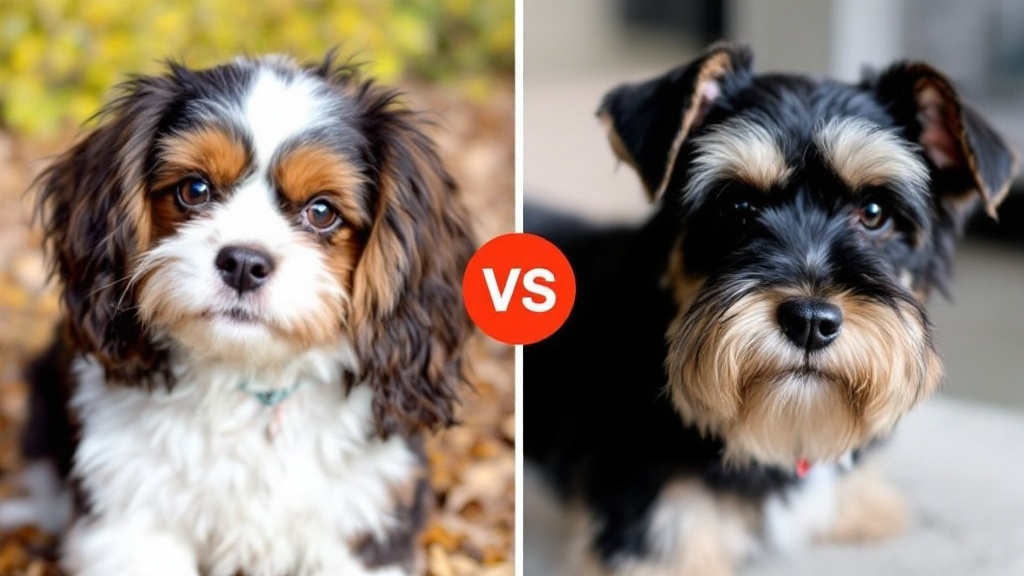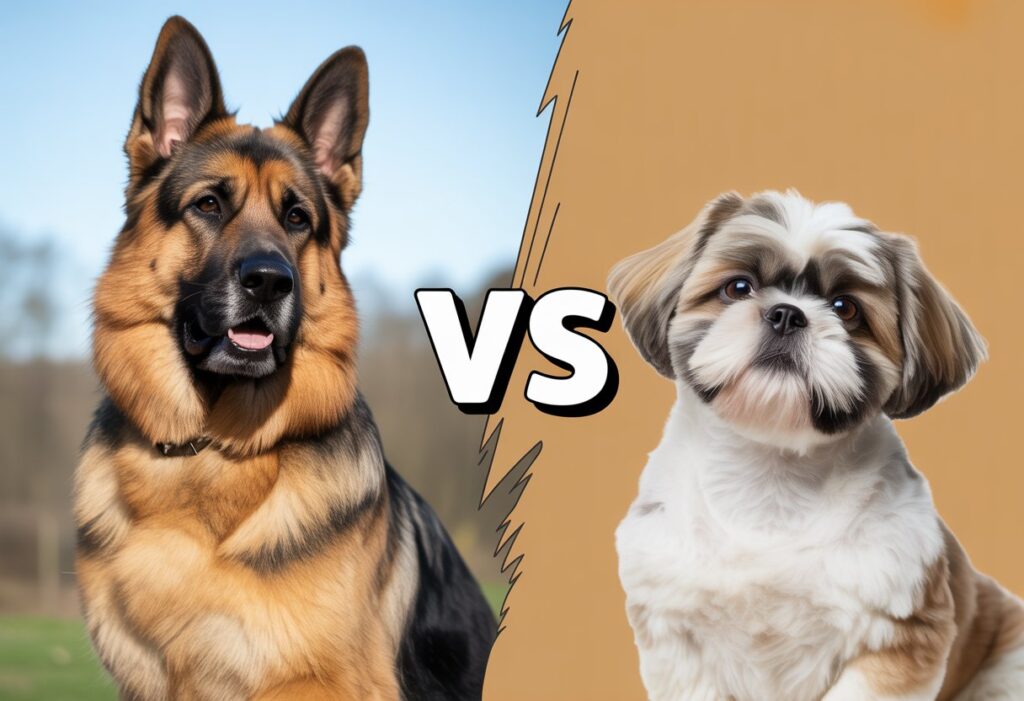Choosing between the Cavalier King Charles Spaniel and the Miniature Schnauzer can be tough if you want a loving, family-friendly dog. Both breeds have friendly personalities, but they’re pretty different in size, grooming, and energy.
Knowing these differences might help you figure out which breed fits your lifestyle best.
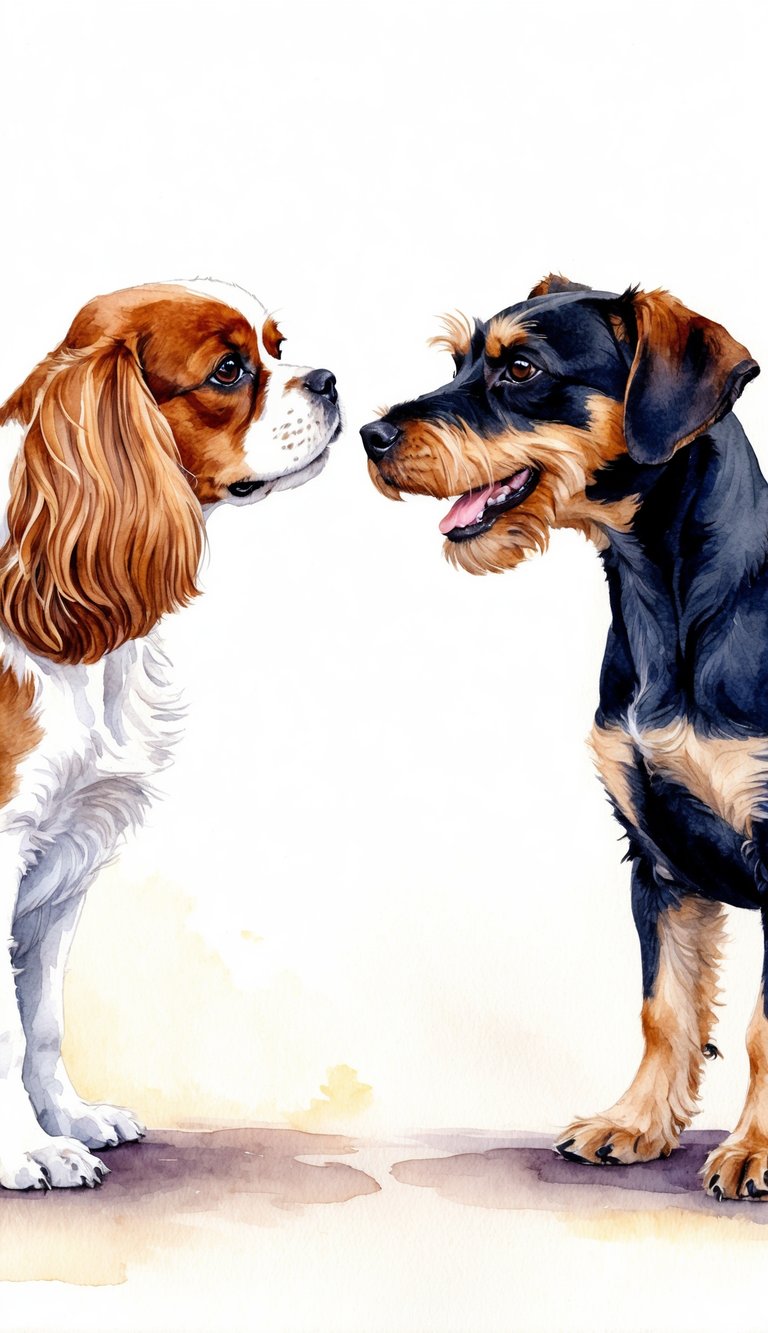
Here’s what you’ll find: how these dogs compare in loyalty, playfulness, and the care they need day-to-day. If you live in an apartment or juggle a busy schedule, understanding these traits could make picking the right dog a whole lot easier.
Maybe you want a gentle companion or a lively little protector. Seeing how these breeds match your daily life is key.
Overview of Cavalier King Charles Spaniel and Miniature Schnauzer
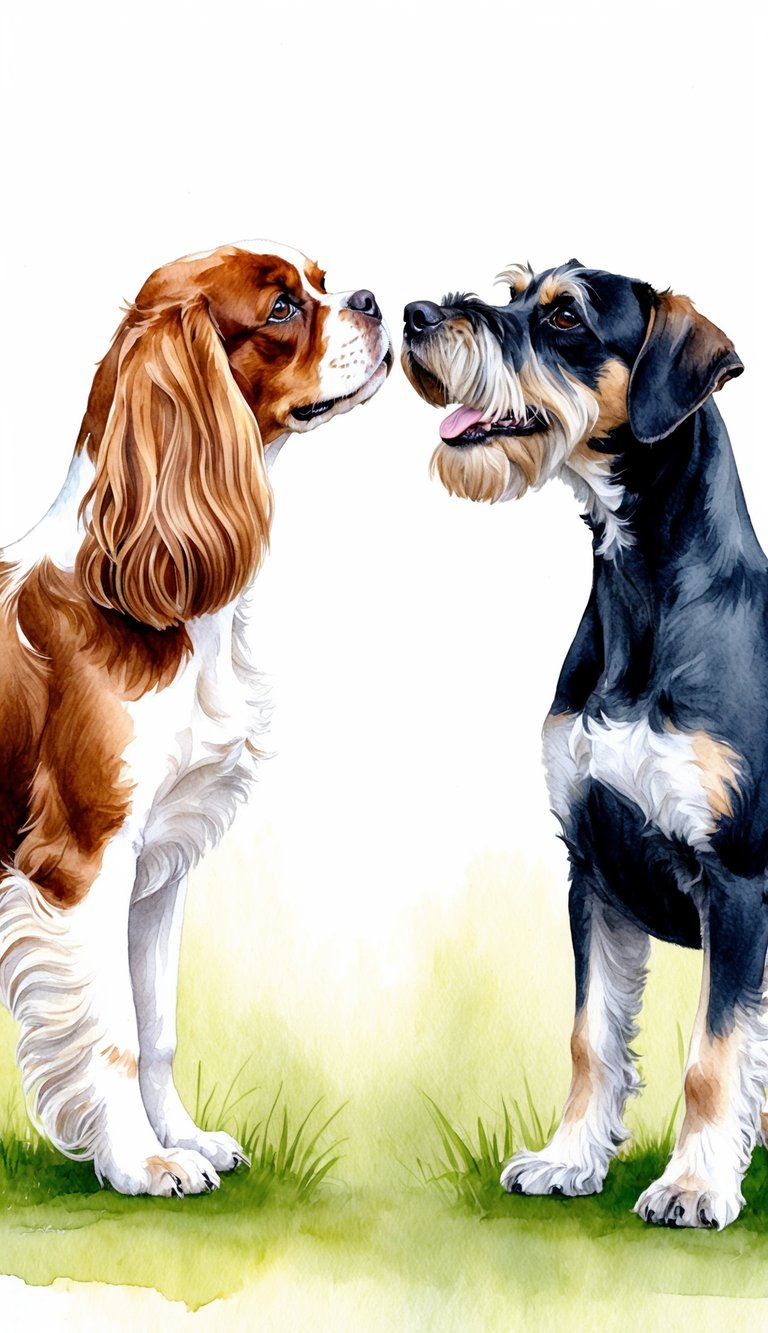
The Cavalier King Charles Spaniel and the Miniature Schnauzer are both popular small dog breeds, but they come from very different backgrounds. It’s worth knowing a bit about where they came from before you pick one as your companion.
Breed Origins and History
The Cavalier King Charles Spaniel comes from England. Its ancestors were toy spaniels that hung out in royal courts in the 17th century.
King Charles II adored these dogs, which is why they carry his name. Over time, people started loving them for their sweet, gentle nature.
The Miniature Schnauzer started out in Germany in the late 1800s. Breeders wanted a smaller version of the Standard Schnauzer, so they crossed them down for farm and ratting work.
This breed is alert and bold but also friendly and loving. Miniature Schnauzers are easy to spot thanks to their wiry coats and those bushy beards.
Recognized Standards
Major kennel clubs, including the American Kennel Club (AKC), recognize both breeds.
Cavalier King Charles Spaniel:
- Height: 12–13 inches
- Weight: 13–18 pounds
- Coat: Long, silky, and comes in Blenheim, Tricolor, Ruby, and Black & Tan
- Personality: Friendly, affectionate, eager to please
Miniature Schnauzer:
- Height: 12–14 inches
- Weight: 11–20 pounds
- Coat: Double coat, wiry on top with a soft undercoat, usually salt and pepper, black, or black and silver
- Personality: Outgoing, intelligent, alert, spirited
Clubs set these standards to help keep each breed’s look and personality consistent. If you’re after a particular temperament or style, these guidelines give you a good idea of what to expect.
Physical Characteristics Comparison
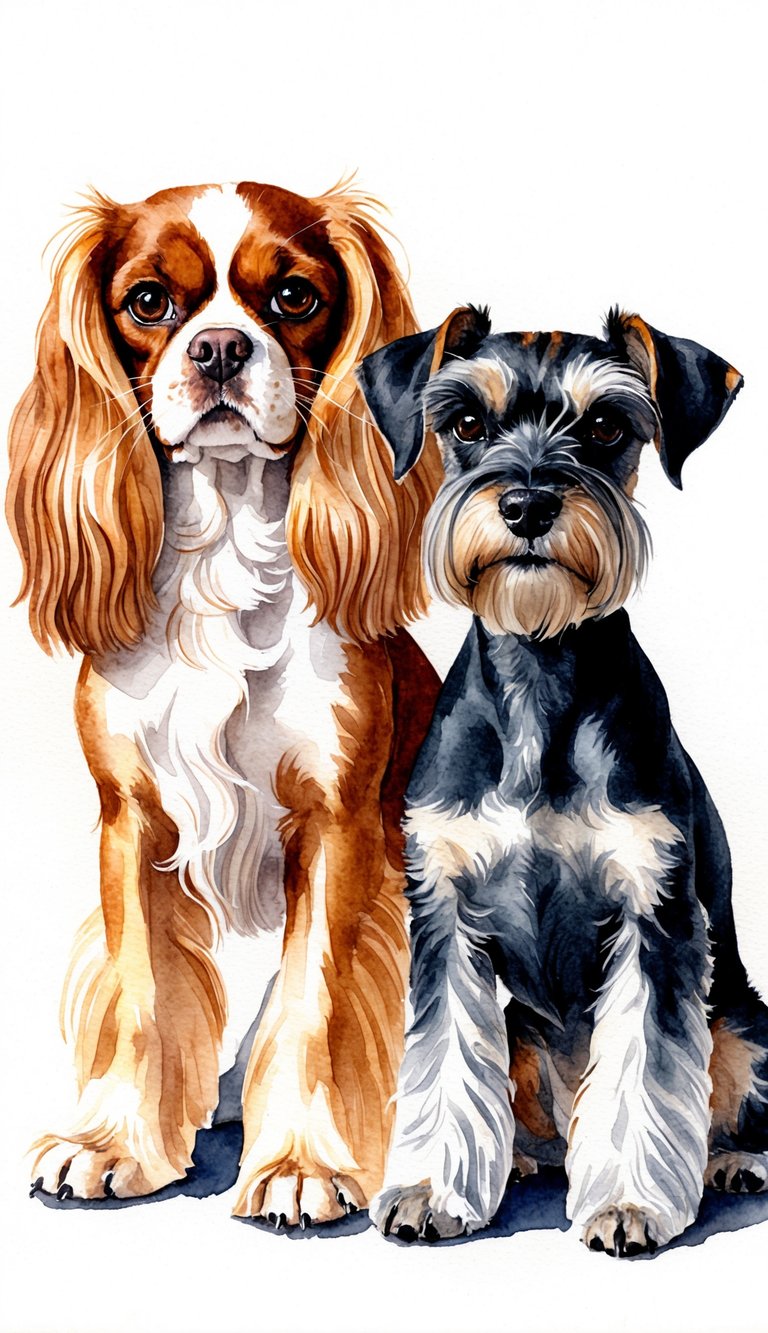
Cavalier King Charles Spaniels and Miniature Schnauzers look pretty different. Their appearances might help you decide which breed fits your home and style.
Size and Weight Differences
Cavalier King Charles Spaniels are considered a toy breed, but they’re a bit larger than some other toys. Adults stand about 30-33 cm (12-13 inches) at the shoulder and weigh 5.9 to 8.2 kg (13-18 pounds).
Miniature Schnauzers are also small, but they’re a little sturdier and stockier. They typically stand 30-36 cm (12-14 inches) tall and weigh 5 to 9 kg (11-20 pounds).
| Breed | Height (cm) | Weight (kg) |
|---|---|---|
| Cavalier King Charles Spaniel | 30-33 | 5.9-8.2 |
| Miniature Schnauzer | 30-36 | 5-9 |
Both breeds are small enough for most homes. The Schnauzer just tends to feel a bit more solid.
Coat Types and Colors
Cavalier King Charles Spaniels have a long, silky coat that’s straight or a little wavy. Their fur feathers at the ears, chest, legs, and tail.
You’ll see Cavaliers in Blenheim (chestnut and white), Ruby (solid red), Tricolor (black, white, and tan), and Black & Tan.
Miniature Schnauzers have a double coat: wiry on top, soft underneath. Their fur is shorter, but it needs regular clipping. They’re most often salt and pepper, black and silver, or all black.
Cavalier coats need regular brushing to avoid mats. Schnauzers need hand-stripping or clipping, especially around their face and legs.
Distinctive Features
Cavalier King Charles Spaniels have a soft, expressive face, big round eyes, and long, floppy ears. Their muzzles are slightly tapered, and their bodies are small but graceful.
Miniature Schnauzers have a rectangular head, bushy eyebrows, and a square muzzle with a beard. Their ears can stand up if cropped or fold forward if left natural. Their bodies are compact and muscular.
The Schnauzer’s beard and eyebrows really make them stand out. Cavaliers, on the other hand, charm people with their gentle faces and flowing ears.
Temperament and Personality Traits
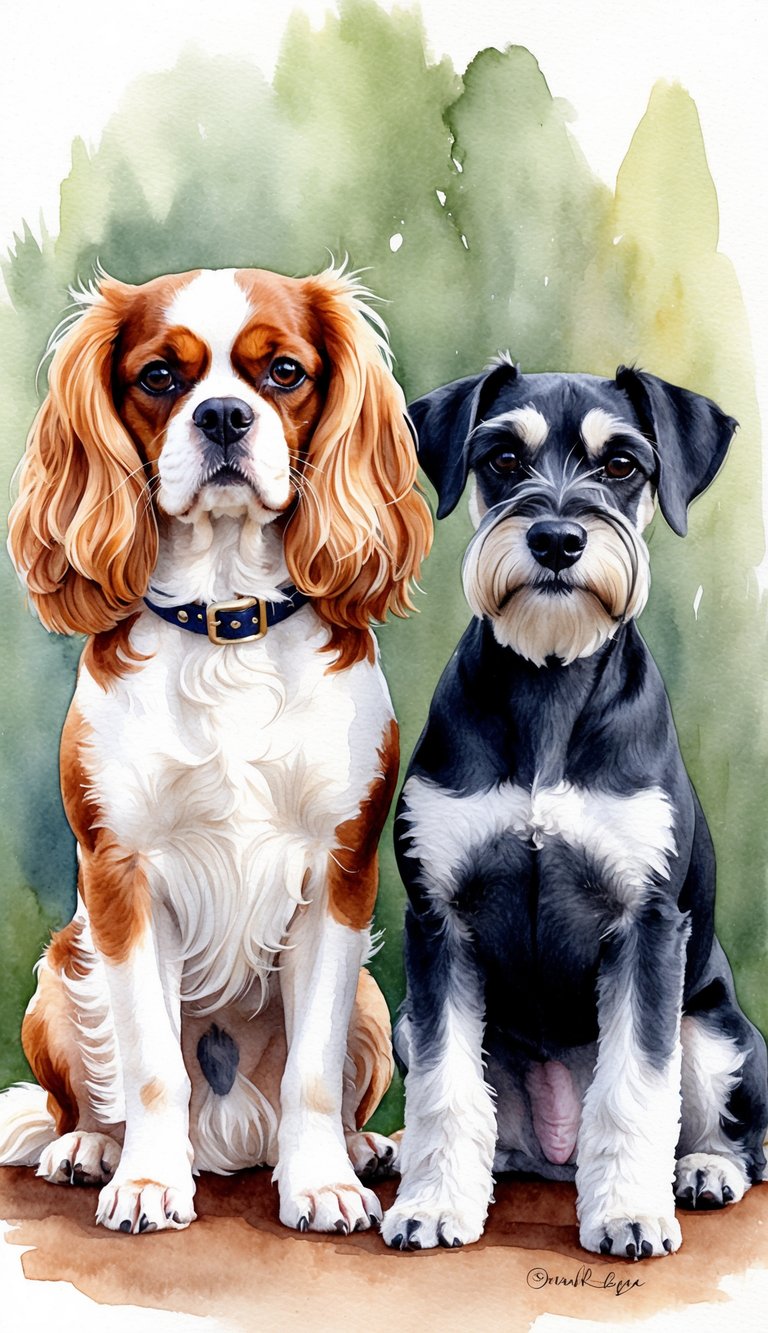
Cavalier King Charles Spaniels and Miniature Schnauzers are both friendly, but their personalities and energy levels can be pretty different. This might make one breed a better fit for your home than the other.
Affection and Loyalty
Cavalier King Charles Spaniels are gentle and affectionate. They love being close and soaking up attention.
These dogs will follow you around and often want to curl up on your lap. If you’re after a dog that’s openly loving and seeks out cuddles, Cavaliers are hard to beat.
Miniature Schnauzers bond closely with their people, but show affection in their own way. They’re loyal and enjoy spending time with family.
Instead of constant snuggles, they might show love by staying alert, playing, or just being nearby. They’re protective and devoted, but not usually clingy.
| Trait | Cavalier King Charles Spaniel | Miniature Schnauzer |
|---|---|---|
| Cuddling | Very frequent | Occasional |
| Loyalty | Deeply attached | Strong and watchful |
| Need for Company | Likes people close | Enjoys time together |
Sociability
Cavalier King Charles Spaniels are social butterflies. They’re friendly with kids, guests, and other pets.
They usually greet new people with a wagging tail and adapt easily to different homes. Their gentle nature makes them easy to introduce to new situations.
Miniature Schnauzers are friendly too, but can be a bit more reserved at first. They’re good with kids and pets if socialized early.
Schnauzers have a lively personality and love to play, but they might bark more when strangers show up or if they hear noises. With training, you can keep their alertness from turning into nonstop barking.
Both breeds get along well with others. Cavaliers are a bit more outgoing, while Schnauzers are a touch more watchful.
Exercise and Activity Needs
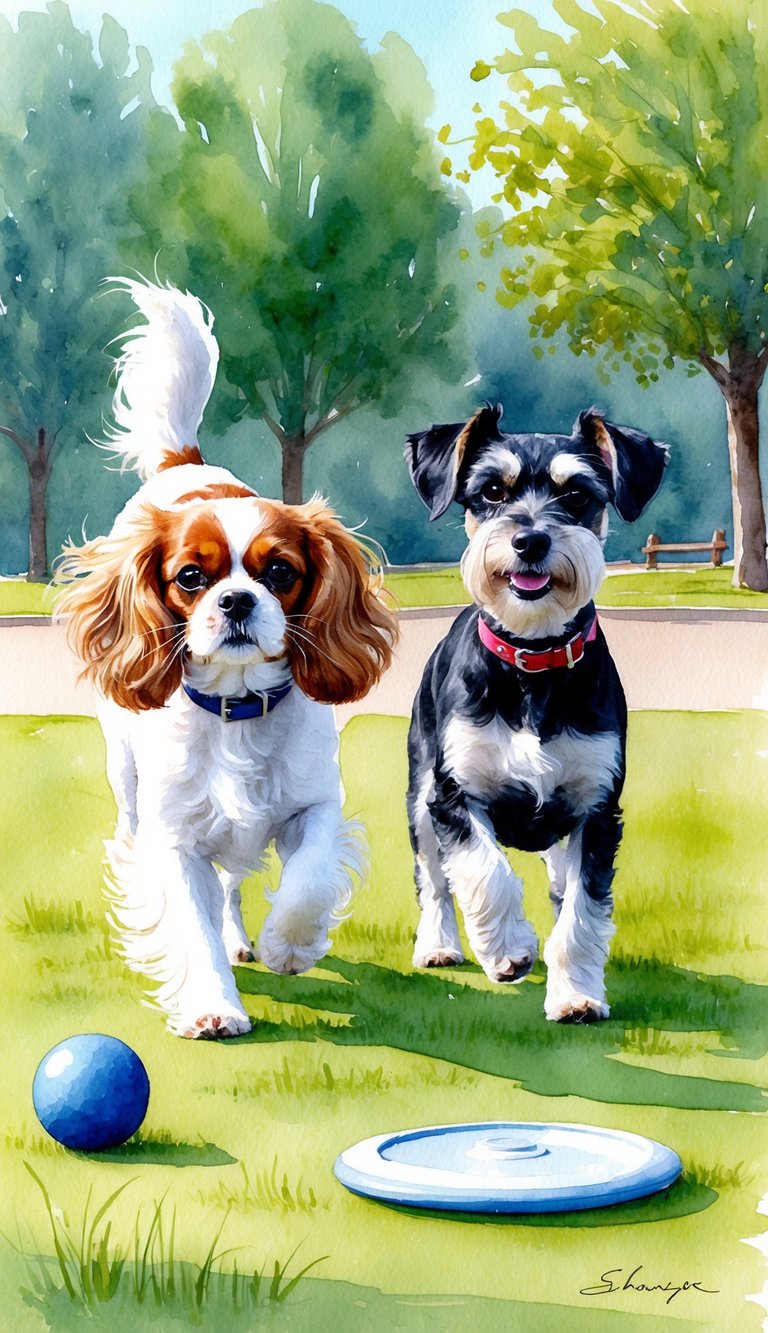
Cavalier King Charles Spaniels and Miniature Schnauzers have different energy levels. If you want a dog that fits your pace, it’s worth knowing what each breed needs.
Daily Exercise Requirements
Cavalier King Charles Spaniels need about 30 to 60 minutes of exercise every day. This might be a couple of short walks, some time in a fenced yard, or gentle play.
They enjoy being with their people and usually prefer moderate activity over anything too intense.
Miniature Schnauzers are more energetic. They need 45 to 90 minutes of activity each day.
These dogs love brisk walks, playing fetch, and even trying out agility or obedience. If they don’t get enough exercise, they can get bored or act out.
If you’re busy or like shorter outings, a Cavalier might be easier. If you’re active and want a dog that keeps up, the Miniature Schnauzer’s higher energy might be a better fit.
Playfulness and Energy Levels
Cavaliers are playful, but in a gentle, relaxed way. They enjoy toys and light games, but tire out faster than a Schnauzer.
They’re happy to chill with you after a quick play session.
Miniature Schnauzers are lively and curious. They love interactive games and can play for ages.
Sometimes, they’ll invent their own games if you’re not available.
Key differences:
| Breed | Playfulness Level | Best Activities |
|---|---|---|
| Cavalier King Charles | Moderate | Fetch, gentle walks, cuddling |
| Miniature Schnauzer | High | Running, agility, puzzle games |
Want a playful but calm companion? The Cavalier is a good pick. Prefer a dog that stays busy and keeps you moving? Go for the Miniature Schnauzer.
Health and Lifespan

Cavalier King Charles Spaniels and Miniature Schnauzers each have their own health needs. Some issues pop up in both breeds, while others are more specific.
Common Health Issues
Cavalier King Charles Spaniels often deal with heart problems, especially mitral valve disease, which can show up pretty young. They’re also prone to ear infections and eye issues like cataracts.
Miniature Schnauzers are at risk for pancreatitis and diabetes. They can develop bladder stones too, which can cause discomfort and trouble urinating.
Typical Lifespan:
| Breed | Average Lifespan |
|---|---|
| Cavalier King Charles Spaniel | 9–14 years |
| Miniature Schnauzer | 12–15 years |
Both breeds can gain weight if you’re not careful with food and exercise. Regular vet visits help catch problems early.
Syringomyelia and Spinal Cord Conditions
Syringomyelia is a serious concern in Cavalier King Charles Spaniels. It’s when fluid-filled cavities form in the spinal cord.
Symptoms include neck pain, scratching (especially around the neck or shoulders), weakness, or wobbly walking.
Miniature Schnauzers rarely get syringomyelia, but they might develop other spinal issues like intervertebral disc disease, usually as they age or after an injury.
If your dog shows signs of pain, odd walking, or seems uncomfortable, get a vet to check them out. Treatment depends on the cause, but it can involve medication or sometimes surgery.
Grooming and Maintenance
Both the Cavalier King Charles Spaniel and the Miniature Schnauzer need regular grooming. Their coats couldn’t be more different, so you’ll want to tailor your routine.
Understanding these differences really helps keep your dog clean and comfortable.
Brushing and Bathing
Cavalier King Charles Spaniels have silky, medium-length fur that tangles up fast. You’ll want to brush your Cavalier three or four times a week to keep mats away and get rid of loose hair.
A soft slicker brush and a comb will do the trick. Bathing once a month is usually enough for most Cavaliers, unless they’ve rolled in something questionable outside.
Pick a gentle dog shampoo—these pups have sensitive skin. Focus especially behind the ears and under the legs, since those spots mat the quickest.
Miniature Schnauzers have a wiry topcoat and a soft undercoat. They barely shed, but their fur can get knotty if you slack on brushing.
Brush your Schnauzer two to three times a week with a slicker or pin brush. Bathing every month or two works, unless your dog finds something stinky.
Their beard is a magnet for food and dirt, so wipe their face after meals and during baths.
Professional Grooming
Cavalier King Charles Spaniels don’t need a ton of trimming. Some owners snip the feet and feathering for tidiness, but you can handle most grooming at home.
A professional groomer can help keep their coat looking sharp if you want. Miniature Schnauzers, on the other hand, usually need pro grooming every 6–8 weeks.
Their classic look—bushy brows, big beard—takes some skill. Groomers will hand-strip or clip their coat to keep it healthy and shaped.
They’ll also trim nails, clean ears, and tidy up paw pads. Keeping up with this routine helps prevent mats and keeps your dog comfy.
If you’re aiming for that traditional Schnauzer style, regular trips to the groomer are a must.
Trainability and Intelligence
Miniature Schnauzers and Cavaliers both want to please, but they don’t approach learning the same way. Their attention spans, motivation, and responsiveness can really shape how training goes.
Obedience Training
The Miniature Schnauzer is eager to learn, though sometimes a bit stubborn. They love treats and praise, so positive reinforcement works best.
Keep training sessions short and consistent—they get distracted easily. Mixing in new tricks or challenges helps keep them interested.
The Cavalier King Charles Spaniel is gentle and sensitive. They usually pick up basic commands quickly and love pleasing their people.
Cavaliers respond best to kind, patient training methods. If you’re too harsh, they might get nervous or shy.
Their playful side can make them lose focus, especially if there’s something exciting happening nearby.
Some breeds, like the Miniature Poodle or Border Collie, tend to learn even faster. Still, both the Cavalier and Schnauzer are easier to train than plenty of other dogs.
Table: Training Ease
| Breed | Training Difficulty | Best Method |
|---|---|---|
| Miniature Schnauzer | Moderate | Consistent, Fun |
| Cavalier King Charles Spaniel | Easy | Gentle, Rewarding |
Problem-Solving Abilities
Miniature Schnauzers are smart and curious. They’ll try to figure out puzzles or sneak around obstacles if you give them the chance.
They love interactive toys or learning advanced tricks. If they get bored, well, they’ll find their own entertainment—sometimes at your expense.
Cavalier King Charles Spaniels are clever, but they’re less independent when it comes to problem-solving. They look to you for guidance and comfort instead of diving into challenges solo.
They enjoy games, though they’re not as driven to solve tough problems on their own. You’ll probably notice they wait for instructions more than they act on impulse.
For complex problem-solving, breeds like the Border Collie and Miniature Poodle really shine. Still, Cavaliers and Schnauzers enjoy puzzle toys or basic agility tasks, especially if you cheer them on.
Compatibility with Families and Other Pets
Both breeds can fit into a family, but their personalities and habits shape how they interact with kids and other animals. Each one brings its own vibe to the house.
Suitability for Children
Cavalier King Charles Spaniels are gentle, affectionate dogs. They love being close to people and show a lot of patience with gentle kids.
Because they’re small and soft-natured, they do best in families where children know how to treat them kindly. Miniature Schnauzers are more energetic and playful.
They often bond closely with kids and keep up with their playfulness. They can handle energetic play, but they’re not always patient if play gets too rough.
Parental supervision is always important. Both breeds are small, so adults should keep an eye out to prevent accidents.
You’ll probably find both breeds eager to join family activities, but the Schnauzer might demand more playtime and mental games.
Table: Child Suitability
| Breed | Patience Level | Activity Needs | Best With |
|---|---|---|---|
| Cavalier King Charles Spaniel | High | Moderate | Gentle children |
| Miniature Schnauzer | Medium | High | Active children |
Interactions with Other Animals
Cavalier King Charles Spaniels usually get along with other pets. They’re friendly and laid-back, and with careful introductions, they’ll accept dogs and cats.
Early socialization makes a big difference. Miniature Schnauzers can live with other animals, but their terrier instincts sometimes kick in—they might chase smaller pets.
They’re not always quick to trust new animals and can get territorial, especially with dogs of the same sex. Introductions and training matter for both breeds.
Watch for jealousy or rough play, especially when you bring a new pet home. If you have cats or small mammals, Cavaliers are generally the safer bet, while Schnauzers might need more supervision and boundaries.
Popularity and Related Breeds
Cavalier King Charles Spaniels and Miniature Schnauzers are both popular, but they attract different kinds of owners. There’s no shortage of other small and medium dogs people compare with these breeds when looking for a new companion.
Common Alternative Breeds
If you’re considering a Cavalier King Charles Spaniel, you might also look at breeds like the Maltese, Shih Tzu, Bichon Frise, and Cocker Spaniel. They’re all friendly and similar in size.
Pugs, Yorkshire Terriers, and Havanese are also favorites for their affectionate personalities and adaptability. For the Miniature Schnauzer, people often check out other terriers like the Border Terrier, Cairn Terrier, and Bedlington Terrier.
Some families go for the Miniature Bull Terrier or Jack Russell Terrier if they want an alert, active dog. Dachshunds, Miniature Pinschers, and Silky Terriers are about the same size, though their personalities can be pretty different.
Larger breeds like the Beagle, Whippet, or Shetland Sheepdog appeal to people who want more energy. But for city life, smaller breeds usually win out.
Breed Popularity Trends
The Cavalier King Charles Spaniel is a favorite in city and suburban homes. You’ll see them on just about every list of top companion dogs.
They often rank with breeds like the French Bulldog, Toy Poodle, and Chihuahua. In the UK and US, Cavaliers have steady demand, especially with families and retirees.
Miniature Schnauzers are known for being smart and are among the most popular terriers. Their hypoallergenic coat is a draw for folks who need low-shedding pets.
They compete with Boston Terriers, Pomeranians, and Dachshunds for popularity. More people seem to want smaller, lower-maintenance breeds these days—think Miniature Poodles or Brussels Griffons.
Big breeds like the English Bulldog or Bernese Mountain Dog are less common in cities, but they’re still favorites in the countryside. Both the Cavalier and Mini Schnauzer have loyal followings, often outpacing similar breeds like the Greyhound, Basset Hound, or Collie..
Choosing the Right Breed for You
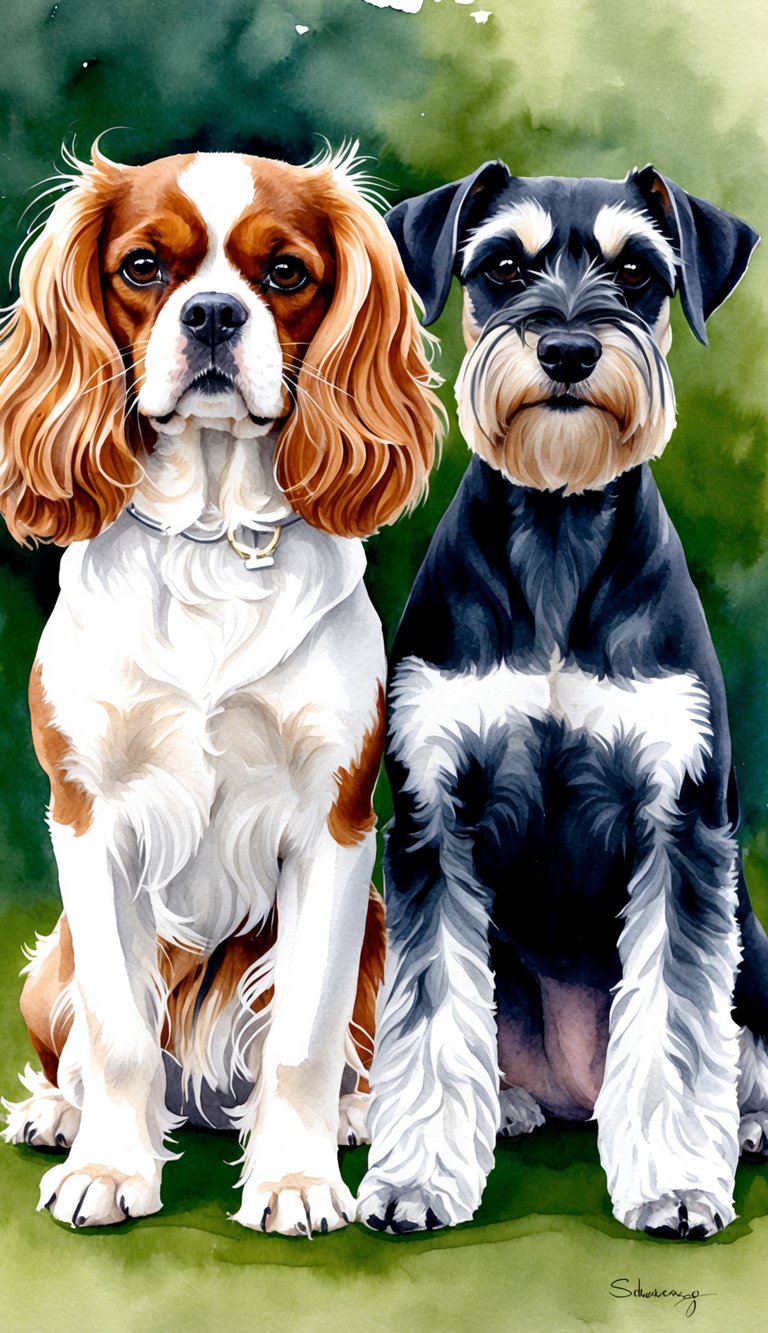
Picking between a Cavalier King Charles Spaniel and a Miniature Schnauzer? It’s not always easy. Take a minute to think about your lifestyle and what you want from a dog.
Each breed brings its own quirks and care needs. Some differences might surprise you.
Cavalier King Charles Spaniel:
- Affectionate and gentle
- Loves getting attention
- Needs a moderate amount of exercise
- Sheds more than a Schnauzer
- Can handle small homes or apartments just fine
Miniature Schnauzer:
- Playful and full of energy
- Craves mental challenges
- Needs daily walks
- Sports a wiry, low-shedding coat
- Tends to bark more
| Feature | Cavalier King Charles Spaniel | Miniature Schnauzer |
|---|---|---|
| Shedding | Higher | Lower |
| Barking | Less frequent | More frequent |
| Size | Small (13-18 lbs) | Small (11-20 lbs) |
| Grooming | Moderate | High (needs trimming) |
| Suitable for Kids | Yes | Yes, with supervision |
| Exercise Needs | Moderate | High |
Prefer a mellow, snuggly dog who just wants to hang out? The Cavalier King Charles Spaniel might be your match.
If you want a lively, alert companion who loves a good walk and a bit of mischief, the Miniature Schnauzer could be the one.
Both breeds can make fantastic family pets. Before you decide, think about how much time you can give to exercise, grooming, and play.

